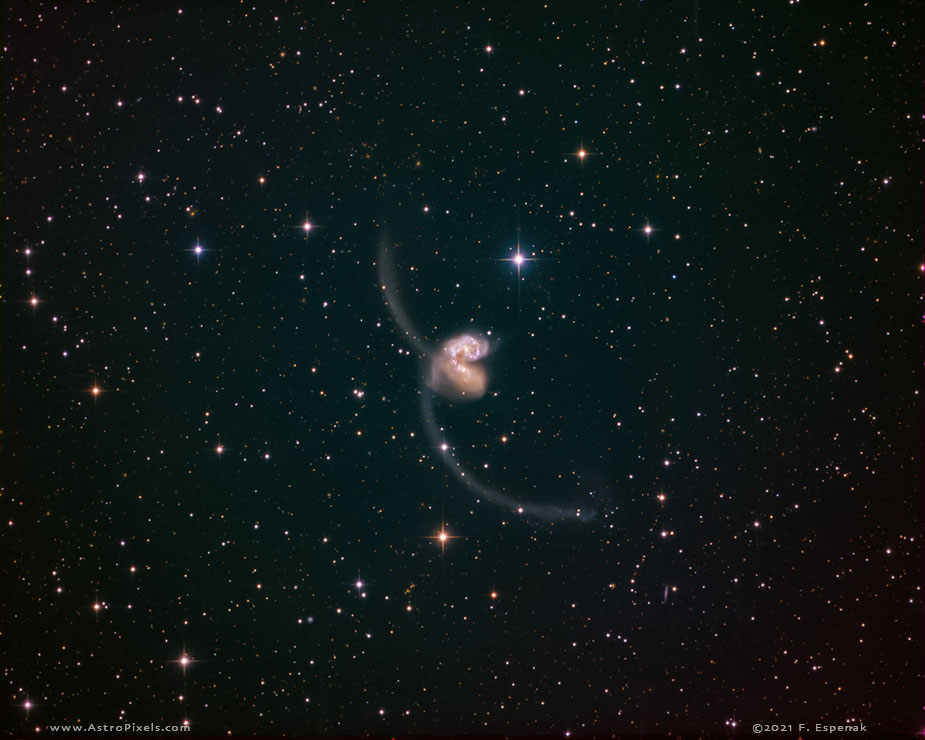NGC 4038/NGC 4039 (Antennae Galaxies)
NGC 4038/NGC 4039 are a pair of interacting galaxies in the constellation Corvus. These two galaxies are known as the Antennae Galaxies because the two long tails of stars, gas and dust ejected from the galaxies as a result of the collision resemble an insect's antennae. The nuclei of the two galaxies are joining to become one giant galaxy. Most galaxies probably undergo at least one significant collision in their lifetimes. This is likely the future of our Milky Way when it collides with the Andromeda Galaxy.
About 1.2 billion years ago, the Antennae were two separate galaxies. NGC 4038 was a barred spiral galaxy and NGC 4039 was a spiral galaxy. Before the galaxies collided, NGC 4039 was larger than NGC 4038. 900 million years ago, the Antennae began to approach one another, looking similar to NGC 2207 and IC 2163. 600 million years ago, the Antennae passed through each other, looking like the Mice Galaxies. 300 million years ago, the Antennae's stars began to be released from both galaxies. Today the two streamers of ejected stars extend far beyond the original galaxies, resulting in the antennae shape.
Within 400 million years, the Antennae's nuclei will collide and become a single core with stars, gas, and dust around it. Observations and simulations of colliding galaxies suggest that the Antennae Galaxies will eventually form an elliptical galaxy.
The Hubble Space Telescope has taken a remarkably detailed close-up image of NGC 4038/NGC 4039.Technical Details
- Object: NGC 4038/NGC 4039
- Other Names: Antennae Galaxies, Arp 244, Caldwell 60/Caldwell 61
- Object Type: a pair of interacting galaxies
- Object Data: Apparent Magnitude = 11.2, Angular Size = 5.2 × 3.1 arc-minutes
- Object Position (Equinox 2000): RA= 12h 02m, Dec= -18° 53´, Constellation = Corvus
- Date: 2021 Mar 11-14 (4 nights)
- Location: Chile Remote Observatory, Observatorio El Sauce, Chile
- Partnership: Operated in partnership with David Churchill
- Telescope: Planewave CDK-17 (with Focal Reducer: f/4.5; FL = 1945mm)
- Camera: QHY 16200A with Integral 7-position Filter Wheel
- Mount: Astro-Physics 1600GTO
- Guider: Agena Starguide II / SBIG STi
- Field of View: 38.9' x 58.3' at 0.64 arc-sec/pixel
- Sub-Exposures: Astronomik Filters
- Luminance: 48 x 10 min = 480 min
- Red: 24 x 10 min = 240 min
- Green: 24 x 10 min = 240 min
- Blue: 24 x 10 min = 240 min - Total Exposure: 20h 00m
- File Name: NGC4039-CDK21-C01w.jpg
- Field of View: 38.9 x 58.3 arc-minutes at 0.64 arc-sec/pixel
- Original Image Size: 3630 x 4540 pixels (16.5 MP); 12.1" x 15.1" @ 300 dpi
- Data Acquisition: David Churchill
- Image Processing: Fred Espenak
- Maxim DL: Image Calibration, Stacking, Digital Development Processing
- Adobe Camera Raw: Noise Reduction
- Photoshop CC: Curves, Levels, Vibrance - Copyright: Fred Espenak
